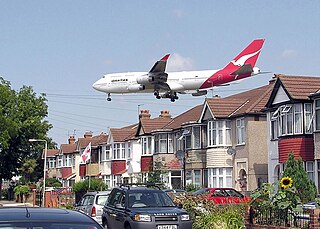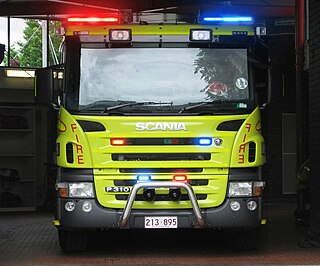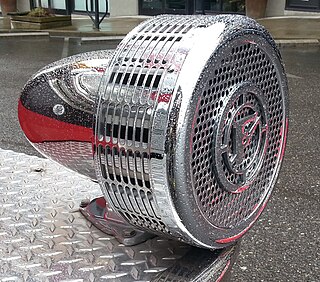
A civil defense siren, also known as an air-raid siren or tornado siren, is a siren used to provide an emergency population warning to the general population of approaching danger. It is sometimes sounded again to indicate the danger has passed. Some sirens, especially within small municipalities, are also used to alert the fire department when needed. Initially designed to warn city dwellers of air raids during World War II, they were later used to warn of nuclear attack and natural disasters, such as tornadoes. The generalized nature of sirens led to many of them being replaced with more specific warnings, such as the broadcast-based Emergency Alert System and the Cell Broadcast-based Wireless Emergency Alerts and EU-Alert mobile technologies.

Noise pollution, or sound pollution, is the propagation of noise or sound with ranging impacts on the activity of human or animal life, most of which are harmful to a degree. The source of outdoor noise worldwide is mainly caused by machines, transport and propagation systems. Poor urban planning may give rise to noise disintegration or pollution, side-by-side industrial and residential buildings can result in noise pollution in the residential areas. Some of the main sources of noise in residential areas include loud music, transportation, lawn care maintenance, construction, electrical generators, wind turbines, explosions and people.

Vehicle audio is equipment installed in a car or other vehicle to provide in-car entertainment and information for the vehicle occupants. Until the 1950s it consisted of a simple AM radio. Additions since then have included FM radio (1952), 8-track tape players, cassette players, record players, CD players (1984), DVD players, Blu-ray players, navigation systems, Bluetooth telephone integration, and smartphone controllers like CarPlay and Android Auto. Once controlled from the dashboard with a few buttons, they can now be controlled by steering wheel controls and voice commands.

Speed bumps are a class of traffic calming devices that use vertical deflection to slow motor-vehicle traffic in order to improve safety conditions. Variations include the speed hump, speed cushion, and speed table.

A car alarm is an electronic device installed in a vehicle in an attempt to discourage theft of the vehicle itself, its contents, or both. Car alarms work by emitting high-volume sound when the conditions necessary for triggering it are met. Such alarms may also cause the vehicle's headlights to flash, may notify the car's owner of the incident via a paging system, and may interrupt one or more electrical circuits necessary for the car to start. Although inexpensive to acquire and install, the effectiveness of such devices in deterring vehicle burglary or theft when their only effect is to emit sound appears to be negligible.

A long-range acoustic device (LRAD), acoustic hailing device (AHD) or sound cannon is a specialized loudspeaker that produces sound at high power for communicating at a distance. It has been used as a method of crowd control, which has caused permanent hearing damage, having an extremely high decibel capacity. Other uses have included for negotiations in siege situations to deal with piracy at sea; for mass notification during natural disasters or other emergencies; and by defense forces, including several navies.

A siren is a loud noise-making device. Civil defense sirens are mounted in fixed locations and used to warn of natural disasters or attacks. Sirens are used on emergency service vehicles such as ambulances, police cars, and fire engines. There are two general types: mechanical and electronic.

An advanced driver-assistance system (ADAS) is any of a groups of electronic technologies that assist drivers in driving and parking functions. Through a safe human-machine interface, ADAS increase car and road safety. ADAS uses automated technology, such as sensors and cameras, to detect nearby obstacles or driver errors, and respond accordingly. ADAS can enable various levels of autonomous driving, depending on the features installed in the car.

A scanner is a radio receiver that can automatically tune, or scan, two or more discrete frequencies, stopping when it finds a signal on one of them and then continuing to scan other frequencies when the initial transmission ceases.

A police car is a ground vehicle used by police and law enforcement for transportation during patrols and responses to calls for service. A type of emergency vehicle, police cars are used by police officers to patrol a beat, quickly reach incident scenes, and transport and temporarily detain suspects, all while establishing a police presence and providing visible crime deterrence.

An air horn is a pneumatic device designed to create an extremely loud noise for signaling purposes. It usually consists of a source which produces compressed air, which passes into a horn through a reed or diaphragm. The stream of air causes the reed or diaphragm to vibrate, creating sound waves, then the horn amplifies the sound making it louder. Air horns are widely employed as vehicle horns, installed on large buses, semi-trailer trucks, fire trucks, trains, and some ambulances as a warning device, and on ships as a signaling device.

Emergency vehicle lighting, also known as simply emergency lighting or emergency lights, is a type of vehicle lighting used to visually announce a vehicle's presence to other road users. A sub-type of emergency vehicle equipment, emergency vehicle lighting is generally used by emergency vehicles and other authorized vehicles in a variety of colors.

Emergency vehicle equipment is any equipment fitted to, or carried by, an emergency vehicle, other than the equipment that a standard non-emergency vehicle is fitted with.

Roadway noise is the collective sound energy emanating from motor vehicles. It consists chiefly of road surface, tire, engine/transmission, aerodynamic, and braking elements. Noise of rolling tires driving on pavement is found to be the biggest contributor of highway noise and increases with higher vehicle speeds.
Traffic signal preemption is a system that allows an operator to override the normal operation of traffic lights. The most common use of these systems manipulates traffic signals in the path of an emergency vehicle, halting conflicting traffic and allowing the emergency vehicle right-of-way, thereby reducing response times and enhance traffic safety. Signal preemption can also be used on tram, light-rail and bus rapid transit systems, to allow public transportation priority access through intersections, and by railroad systems at crossings to prevent collisions.

Mobile radio or mobiles refer to wireless communications systems and devices which are based on radio frequencies, and where the path of communications is movable on either end. There are a variety of views about what constitutes mobile equipment. For US licensing purposes, mobiles may include hand-carried,, equipment. An obsolete term is radiophone.

The Q2B siren ("Q-siren") is an electromechanical siren that is produced by the Federal Signal Corporation and is most recognizable for its sound, which is trademarked, and the look of the siren.
Federal Signal Corporation is an American manufacturer headquartered in Oak Brook, Illinois. Federal Signal manufactures street sweeper vehicles, public address systems, emergency vehicle equipment, and emergency vehicle lighting.

A horn is a sound-making device that can be equipped to motor vehicles, buses, bicycles, trains, trams, and other types of vehicles. The sound made usually resembles a "honk" or a "beep". The driver uses the horn to warn others of the vehicle's approach or presence, or to call attention to some hazard. Motor vehicles, ships and trains are required by law in some countries to have horns. Like trams, trolley cars and streetcars, bicycles are also legally required to have an audible warning device in many areas, but not universally, and not always a horn.

New Orleans Emergency Medical Services is the primary provider of advanced life support emergency medical services to the city of New Orleans, Louisiana, United States. Unlike most other emergency medical services in the United States, New Orleans EMS operates as a third service and is not part of the New Orleans Fire Department; rather, New Orleans EMS is operated by the New Orleans Health Department and the New Orleans Office of Homeland Security and Emergency Preparedness.


















